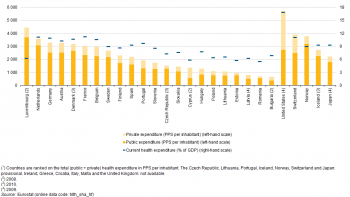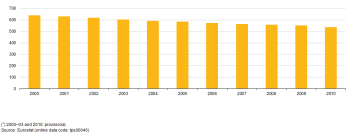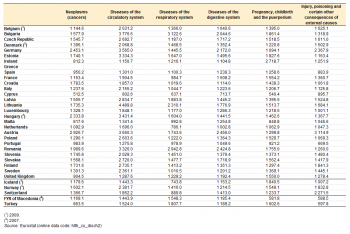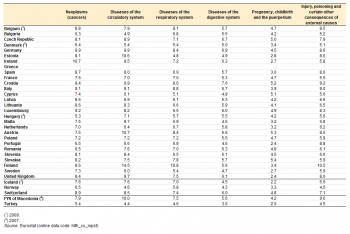Archive:Healthcare statistics
- Data extracted in April 2015. Most recent data: Further Eurostat information, Main tables and Database. Planned article update: April 2016.


(% of current health expenditure) - Source: Eurostat (hlth_sha_hf)

(% of current health expenditure) - Source: Eurostat (hlth_sha_hc)

(% of current health expenditure) - Source: Eurostat (hlth_sha_hp)

(per 100 000 inhabitants) - Source: Eurostat (hlth_rs_prs), (tps00046) and (hlth_co_disch2t)

(per 100 000 inhabitants) - Source: Eurostat (tps00046)

(per 100 000 inhabitants) - Source: Eurostat (tps00168) and (tps00047)

(ISHMT — international shortlist for hospital morbidity tabulation), 2010
(per 100 000 inhabitants) - Source: Eurostat (hlth_co_disch2)

(ISHMT — international shortlist for hospital morbidity tabulation), average length of stay, 2010
(days) - Source: Eurostat (hlth_co_inpst)
This article presents key statistics on monetary aspects of healthcare in the European Union (EU); these data complement data on healthcare resources and activities. Healthcare systems are organised and financed in different ways across the EU Member States, but most Europeans would agree that universal access to good healthcare, at an affordable cost to both individuals and society at large, is a basic need.
Monetary statistics may be used to evaluate how a country’s healthcare system responds to the challenge of universal access to good healthcare, through measuring financial resources within the healthcare sector and the allocation of these resources between healthcare activities (for example, preventive and curative care) and groups of healthcare providers (for example, hospitals and ambulatory centres).
This article forms part of an online publication on health statistics.
Main statistical findings
Healthcare expenditure
The Netherlands and France had the highest current healthcare expenditure relative to GDP among the EU Member States, although this ratio was higher in the United States
The level of current healthcare expenditure in Germany was around EUR 290 billion in 2012, equivalent to 10.9 % of gross domestic product (GDP). In Belgium, current healthcare expenditure was also equivalent to 10.9 % of GDP, with France (11.2 %) and the Netherlands (11.8 %) the only EU Member States for which data are available to report higher ratios. Denmark and Austria also reported that current healthcare expenditure exceeded 10.0 % of GDP. Among the non-member countries shown in Table 1, the ratio of current healthcare expenditure to GDP reached or exceeded 10.0 % in New Zealand, Japan, Canada (all 2011 data) and Switzerland, peaking at 16.2 % in the United States. By contrast, current healthcare expenditure accounted for less than 6.5 % of GDP in Lithuania, Poland, Latvia (2010 data) and Estonia, with Romania recording the lowest ratio (5.5 %).
In euro terms, current healthcare expenditure per inhabitant in Luxembourg was more than 15 times as high as in Romania
Relative to population size and in euro terms, current healthcare expenditure was highest among the EU Member States in Luxembourg, at EUR 5.5 thousand per inhabitant in 2012; among the non-member countries included in Table 1 only the United States reported higher expenditure per inhabitant. Denmark and the Netherlands also recorded current healthcare expenditure above EUR 4.0 thousand per inhabitant. Nine EU Member States reported expenditure of less than EUR 1.0 thousand per inhabitant, with the lowest level (EUR 358 per inhabitant) in Romania. As such, among the EU Member States, the ratio between the highest and lowest expenditure per inhabitant was 15.5 to 1. The disparity was less after adjusting for price differences, by expressing expenditure in purchasing power standards (PPS): Luxembourg (PPS 4.1 thousand per inhabitant) and Romania (PPS 735 per inhabitant) maintained their positions at each end of the ranking, but the ratio between their average values fell to 5.5 to 1.
Public and private healthcare expenditure by financing agent
Figure 1 provides a simple analysis of healthcare expenditure by financing agent, distinguishing public and private expenditure. With the exception of Cyprus, public expenditure exceeded private expenditure in all EU Member States and this was also true in all of the non-member countries in Figure 1 except for the United States. At the other end of the scale, the share of public expenditure in total current healthcare expenditure was close to or in excess of 80.0 % in Estonia, Romania, Sweden, Luxembourg, the Czech Republic, Denmark and the Netherlands, as well as in Iceland, Japan, New Zealand (all 2011 data) and Norway.
In most EU Member States social security funds provided more financing of healthcare than did general government
Table 2 provides a more detailed analysis of healthcare expenditure between public and private agents that incur healthcare expenditure. An analysis of public financing of healthcare suggests that social security funds were a somewhat more common means for funding healthcare within the EU Member States. For example, these accounted for three quarters or more of overall spending on healthcare in the Czech Republic (79.2 %), the Netherlands (78.3 %) and Croatia (76.9 %) in 2012, but less than 5.0 % in Spain, Portugal (2011 data), Cyprus, Denmark and Latvia (2010 data); social security funds accounted for just 1.4 % of current healthcare expenditure in Canada in 2011. By contrast, Denmark and Sweden reported that general government financing accounted for more than four fifths (88.2 % and 81.2 % respectively) of their total current expenditure on healthcare.
The major source of private funding was direct household payments, referred to as out-of-pocket expenditure, which peaked in terms of its share of current healthcare expenditure in Cyprus (47.2 %) and Bulgaria (44.5 %), falling to a single-digit share in France and the Netherlands (7.8 % and 6.0 % respectively). Private insurance generally represented a small share of healthcare financing among the EU Member States for which data are available; its relative share only exceeded 10 % in France and Slovenia (2011 data) among the EU Member States; in Canada private insurance accounted for 12.9 % of current healthcare expenditure in 2011 while in the United States this share was 34.8 % in 2012.
Healthcare expenditure by function
Curative and rehabilitative services accounted for more than half of current healthcare expenditure in the majority of EU Member States
The functional patterns of healthcare expenditure presented in Table 3 show that in 2012 curative and rehabilitative services incurred more than 50.0 % of current healthcare expenditure in the majority of EU Member States for which data are available, the exceptions being Belgium, Bulgaria, Slovakia (both 2011 data) and Romania; in Canada (2011 data) curative and rehabilitative services also incurred less than half of current healthcare expenditure.
Medical goods dispensed to outpatients accounted for around one quarter of total current healthcare expenditure
Medical goods dispensed to outpatients was the second largest function, with average spending accounting for around one quarter of total current healthcare expenditure, although with a significant degree of variation: the lowest share of 10.1 % was recorded for Denmark, rising to more than one third of the total in Hungary (35.4 %), Slovakia (38.0 %, 2011 data) and Bulgaria (41.4 %, 2011 data).
Services related to long-term nursing care accounted for less than 10.0 % of current healthcare expenditure in more than half of the EU Member States for which data are available, but for more than one fifth of the total in the Benelux countries and in Denmark, peaking at 25.1 % in the Netherlands: an even higher share (28.9 %) was recorded in Norway. It should be noted that limitations within the data compilation exercise make it difficult to separate the medical and social components of expenditure for long-term nursing care, leading to an inevitable impact on cross-country comparisons. In addition, the relatively low share reported for many EU Member States could well be due to the main burden of long-term nursing care residing with family members with no payment being made for providing these services.
The proportion of current healthcare expenditure incurred by ancillary services to healthcare (such as laboratory testing or the transportation of patients) varied significantly among EU Member States, ranging from 2.0 % in the Netherlands to 8.8 % in Portugal, with Cyprus (10.7 %) and Estonia (11.1 %) above this range; these services accounted for an even lower share in Japan (0.7 %, 2011 data), South Korea (1.0 %) and Iceland (1.7 %). Similarly, expenditure related to prevention and public health programmes exhibited large discrepancies between EU Member States. In both cases these figures are likely to provide an under-estimate of the true values, as part of the expenditure on these services is attributed to medical treatment and as such may be recorded under the heading of curative care.
Expenditure on healthcare administration and health insurance ranged from 1.2 % of current healthcare expenditure in Poland and 1.3 % in Cyprus through to 3.9 % in the Netherlands, 4.9 % in Belgium, 5.4 % in Germany and 6.1 % in France. In Norway the share of current healthcare expenditure dedicated to administration and health insurance was particularly low (0.6 %), while in the United States, which had a very high share of expenditure financed by private insurance, the share reached 7.5 %.
Healthcare expenditure by provider
An analysis of current healthcare expenditure by provider is shown in Table 4. It should be borne in mind that healthcare providers classified under the same group do not necessarily perform the same set of activities. For example, hospitals may offer day care, out-patient, ancillary or other types of service, in addition to in-patient services.
In most EU Member States hospitals were the main provider of healthcare in expenditure terms
Hospitals generally accounted for the highest proportion of current healthcare expenditure, ranging from 25.8 % of the total in Slovakia (2011 data) to a share that was between 44.0 % and 47.0 % in Cyprus, Denmark, Estonia and Sweden, peaking at 49.4 % in Greece; Japan (46.5 %, 2011 data) also reported a particularly high share for hospitals. The second most important category was that of ambulatory care providers, its share ranging from 14.5 % of current healthcare expenditure in Romania to more than 30.0 % in Poland, Germany, Belgium, Luxembourg, Portugal (2011 data), Cyprus and Finland. The share of various retail establishments and other providers of medical goods in current healthcare expenditure varied by a factor of three, with the lowest shares, below 15.0 %, being recorded in Sweden, the Netherlands, Luxembourg and Denmark. Most of the EU Member States reported that retail establishments and other providers of medical goods accounted for a share between 16.0 % and 32.0 % of current healthcare expenditure, a share that rose above 35.0 % in Hungary, Slovakia and Bulgaria (both 2011 data).
Long-term health care expenditure
Among the EU Member States, the share of current healthcare expenditure used for long-term health care peaked at 40.3 % in Sweden
The share of long-term healthcare services in current healthcare expenditure ranges enormously among the EU Member States as can be seen in Figure 2. In five Member States these services accounted for less than 2.0 % of current healthcare expenditure and in a further six the share was also less than 10.0 %. At the other end of the scale, in a total of six Member States the share was more than double this level, over 20.0 %, among which it reached 34.9 % in the Netherlands and 40.3 % in Sweden. Among the non-member countries shown in Figure 2 shares below 10.0 % were recorded for Australia (2011 data) and the United States, while shares over 20.0 % were reported for Switzerland, Japan (2011 data) and Norway.
Unsurprisingly, the high shares of long-term health care in total current healthcare expenditure in Sweden and the Netherlands are reflected in the data presented in Table 5: expenditure on long-term health care in the Netherlands was equivalent to 4.1 % of GDP in 2012 and in Sweden it was equivalent to 3.7 %. In Finland, Denmark and Belgium this ratio was between 2.4 % and 2.6 %. Seven Member States reported that long-term health care expenditure was equivalent to 0.9–1.6 % of GDP, with this expenditure not exceeding 0.6 % of GDP in the 12 remaining EU Member States for which data are available. Among the non-member countries shown in Table 5, the ratio of long-term health care expenditure to GDP exceeded 2.0 % in Japan (2011 data), Switzerland and Norway, while it was as low as 0.1 % (2011 data) in Australia.
Long-term healthcare expenditure in 2012 exceeded EUR 1.0 thousand per inhabitant in Sweden, the Netherlands, Luxembourg and Denmark
Relative to population size and in euro terms, long-term healthcare expenditure was highest among the EU Member States in Sweden, at EUR 1.6 thousand per inhabitant in 2012; among the non-member countries included in Table 1 only Norway reported a higher level. The Netherlands, Luxembourg and Denmark also recorded long-term healthcare expenditure above EUR 1.0 thousand per inhabitant. A total of 12 EU Member States reported less than EUR 100 of long-term healthcare expenditure per inhabitant, with the lowest expenditure averaging 37 cents per inhabitant in Bulgaria (2011 data).
Data sources and availability
Data in this article are generally presented for 2012, however, data for Bulgaria, Portugal, Slovenia and Slovakia refer to 2011 and data for Latvia refer to 2010. Among the non-member countries data for Australia, Canada, Japan and New Zealand refer to 2011, as do data for Norway for healthcare expenditure by provider in Table 4. No data are available in this article for four of the EU Member States, namely, Ireland, Italy, Malta and the United Kingdom.
Key concepts
Total current healthcare expenditure quantifies the economic resources of both the public and private sectors dedicated to healthcare, with the exception of those related to capital investment. It reflects current expenditure of resident units on the final consumption of goods and services directed at improving the health status of individuals and of the population.
Long-term healthcare consists of a range of medical and personal care services that are consumed with the primary goal of alleviating pain and suffering and reducing or managing the deterioration in health status in patients with a degree of long-term dependency.
System of health accounts
Eurostat, the Organisation for Economic Cooperation and Development (OECD) and the World Health Organisation (WHO) have established a common framework for a joint healthcare data collection. Following this framework, EU Member States submit their data to Eurostat on the basis of a gentlemen’s agreement. The data collected relates to healthcare expenditure following the methodology of the system of health accounts (SHA) as well as statistics on human and physical resources in healthcare.
The SHA provides a framework for interrelated classifications and tables relating to the international reporting of healthcare expenditure and financing. The set of core SHA tables addresses three basic questions: i) who finances healthcare goods and services; ii) which healthcare providers deliver them, and; iii) what kinds of healthcare goods and services are consumed. Consequently, the SHA is organised around a tri-dimensional system for the recording of health expenditure, by means of the international classification for health accounts (ICHA), defining:
- healthcare expenditure by financing agents (ICHA-HF) — which provides an analysis of public and private units that directly pay providers for their provision of healthcare goods and services;
- healthcare expenditure by provider (ICHA-HP) — which classifies units contributing to the provision of healthcare goods and services such as hospitals, various outpatients settings, diagnosis centres or retailers of medical goods;
- healthcare expenditure by function (ICHA-HC) — which details the split in healthcare expenditure following the purpose of healthcare activities — such as, health promotion, curing illnesses, rehabilitation or long-term care.
Data coverage is close to 100 % for the first-digit level of each of the three core classifications, but ranges between 75 % and 85 % at the second-digit level. However, it is possible that despite relatively high rates of coverage, there may be departures from the standard classifications. Expenditure reported under some of these ICHA categories may be under or overestimated and it is recommended to refer to specific country metadata before analysing the data in detail.
Healthcare expenditure — methodology
Statistics on healthcare expenditure are based on administrative (register-based) data sources and various surveys, as well as estimations made within the EU Member States, reflecting national ways of organising healthcare and different reporting systems for the collection of statistics pertaining to healthcare.
Statistics on healthcare expenditure are documented in this background article which provides information on the scope of the data, its legal basis, the methodology employed, as well as related concepts and definitions. For country specific notes on this data collection, please refer to the annexes of the online metadata for these statistics.
Context
Access to healthcare, the introduction of technological progress and greater patient choice is increasingly being considered against a background of financial sustainability. Many of the challenges facing governments across the EU were outlined in the European Commission’s White paper titled ‘Together for health: a strategic approach for the EU 2008–2013’ (COM(2007) 630 final).
In February 2013, the European Commission adopted a Communication titled ‘Towards social investment for growth and cohesion’ (COM(2013) 83 final). The main axes of the Communication include: ensuring that social protection systems respond to people’s needs at critical moments throughout their lives; simplified and better targeted social policies, to provide adequate and sustainable social protection systems; and upgrading active inclusion strategies in the EU Member States. Concerning health, the Communication notes the differences in the accessibility to and quality of healthcare between Member States as well as underlining the need for reforms of healthcare systems with the twin aim to ensure access to high quality healthcare and to use public resources more efficiently. In the context of social investment throughout an individual’s lifetime, the Communication notes that investing in health, starting from an early age, allows people to remain active longer and in better health, raises the productivity of the workforce and lowers the financial pressures on healthcare systems.
In March 2014, the third multi-annual programme of EU action in the field of health for the period 2014–20 was adopted (Regulation (EU) No 282/2014) under the title ‘Health for Growth’. This new programme emphasises the link between health and economic prosperity, as the health of individuals directly influences economic outcomes such as productivity, labour supply and human capital. More information is provided in the introductory article for health statistics.
See also
Online publications
Methodology
General health statistics articles
- Health statistics introduced
- Healthcare resources and activities statistics
- The EU in the world — health
Further Eurostat information
Database
- Health care (hlth_care), see:
- Healthcare expenditure (hlth_sha)
Dedicated section
Methodology / Metadata
- Healthcare expenditure (ESMS metadata file — hlth_sha_esms)
Source data for tables and figures (MS Excel)
External links
- European Commission — Directorate-General for Health and Food Safety — European Core Health Indicators (ECHI)
- European Commission — Directorate-General for Health and Food Safety — Public health
- Joint OECD / European Commission report ‘Health at a Glance: Europe 2014’
- OECD — Health policies and data
- WHO Global Health Observatory (GHO)
- World Health Organisation (WHO) — Health systems